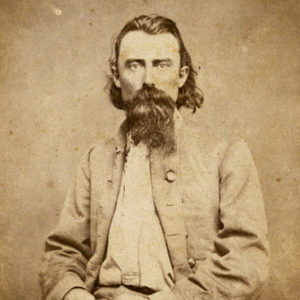calsfoundation@cals.org
Batesville Expedition
| Location: | Independence County |
| Campaign: | March 19–April 4, 1864, Expedition from Rolling Prairie to Batesville, Arkansas, with skirmishes |
| Date: | March 19–April 4, 1864 |
| Principal Commanders: | Captain William F. Orr (US); Unknown (CS) |
| Forces Engaged: | Second Arkansas Cavalry (US); Possible elements of Freeman’s and McRae’s Brigades, other unknown elements (CS) |
| Estimated Casualties: | None (US); 37 killed, 6 prisoners, and 2 wounded (CS) |
| Result: | Union victory |
While escorting a treasury agent to Batesville (Independence County), a detachment of the Second Arkansas Cavalry (US) commanded by Captain William F. Orr defeated various Confederate units around the area of Independence County in late March and early April 1864. Accomplishing their mission, known as the Batesville Expedition, the unit returned to its base at Rolling Prairie (Boone County) with no reported losses.
Surprising Confederate forces in Batesville on Christmas Day 1863, Union colonel Robert R. Livingston occupied the town with no real resistance, reestablishing the Union presence there. An outstanding victory for Livingston, the Federals soon discovered that yet again they lacked the strength to occupy Batesville continually due to supply issues. The necessity to maintain a strong link with the river landing at Jacksonport (Jackson County) for supply, along with the presence of several small bands of regulars and guerrillas in the region, resulted in sporadic military contact and confusing intelligence gathering. When strength allowed, the Federals in Batesville attempted to engage units under Confederate leaders Brigadier General Dandridge McRae, Colonel Thomas R. Freeman, and Captain George Rutherford in the area.
On March 14, 1864, Major James A. Melton, Second Arkansas Cavalry, received orders to dispatch a force to escort a treasury agent to Union-occupied Batesville. Captain William F. Orr, with a detachment from the Second Arkansas Cavalry, left Rolling Prairie, which was located in Carroll County during the Civil War. After preparing for the movement, Orr’s column crossed the White River some twelve miles from Yellville (Marion County) without Confederate contact on March 19. The Federal advance guard engaged Confederates for the first time two days later in the Arkansas wilderness. Believed by the Federals to be elements under the command of Lieutenant Colonel Joseph B. Love of Colonel Freeman’s Brigade, the Confederates were quickly defeated, fleeing without real incident.
Orr’s column rode into Batesville on March 23. As the bulk of the troopers in the Second Arkansas Cavalry detachment came from the north-central Arkansas area, sixty-eight of the 104-man force was granted a two-day leave of absence to visit their families. Traveling in groups for protection, one group was attacked at Sulphur Rock (Independence County). During the skirmish, two men were captured, but they were later released after being robbed by their captors.
Upon hearing of this assault on his troops, Orr sent the remains of the force, some thirty-six men, toward Sulphur Rock under Captain Albert A. Irwin. Discovering the Confederates had moved, they gave chase, crossing the White River by swimming their horses over it at Magness Landing (Independence County). Overtaking the Confederates some six miles from the landing, the Federals routed the Confederates, killing four, wounding one, and taking two Confederates prisoner. Additionally, three Union soldiers were freed from Confederate captivity. As the Confederates fled, the Federals followed to within a few miles of a site where they believed a larger Confederate force was located, thought to be the headquarters area of Brigadier General Dandridge McRae. Not wanting to risk a larger engagement, the Union force returned to Batesville with no casualties during this event.
After all the men on leave returned, Orr’s force rode out of Batesville on March 26, remaining on the east side of the White River, where they surprised and destroyed a reconnoitering party from Freeman’s Brigade. The sole survivor told the Federals that Freeman endeavored to cut off the Union column before it returned to Rolling Prairie. Perhaps the destruction of the reconnaissance party or the lack of solid intelligence prevented accurate Confederate pursuit, but Orr’s column crossed the White River without incident and returned to Rolling Prairie by April 2.
Overall, this movement was a clear win for the Federals with the deaths of thirty-seven, imprisonment of six, and wounding of two Confederates. Additionally, three Union prisoners were reclaimed and the treasury agent was delivered to Batesville as ordered. Orr’s group also captured twenty-six horses, sixteen stands of arms, and one Union saddle. The Federals reported only two men temporarily taken prisoner.
By April 16, the pressures on Livingston’s Union forces in Batesville compelled him to move the bulk of his forces to Jacksonport to improve communication and supply access, leaving but scant forces in Batesville. By May 1864, it was clear that Confederate brigadier general Joseph O. Shelby was moving into the region with large numbers. Once again, Batesville was abandoned on May 20, 1864, only to be followed by Jacksonport on May 26, 1864. The Confederates under Shelby claimed possession of Batesville and Jacksonport once more.
For additional information:
The War of the Rebellion: A Compilation of the Official Records of the Union and Confederate Armies. Series I, Vol. 34, Part 1. Washington DC: Government Printing Office, 1891, pp. 650–651.
Derek Allen Clements
Black River Technical College
 Civil War Timeline
Civil War Timeline ACWSC Logo
ACWSC Logo  Joseph Shelby
Joseph Shelby 




Comments
No comments on this entry yet.